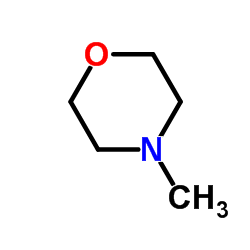4-methylmorpholine

4-methylmorpholine structure
|
Common Name | 4-methylmorpholine | ||
|---|---|---|---|---|
| CAS Number | 109-02-4 | Molecular Weight | 101.147 | |
| Density | 0.9±0.1 g/cm3 | Boiling Point | 114.1±15.0 °C at 760 mmHg | |
| Molecular Formula | C5H11NO | Melting Point | −66 °C(lit.) | |
| MSDS | Chinese USA | Flash Point | 23.9±0.0 °C | |
| Symbol |



GHS02, GHS05, GHS07 |
Signal Word | Danger | |
|
Hairpin assembly circuit-based fluorescence cooperative amplification strategy for enzyme-free and label-free detection of small molecule.
Talanta 143 , 101-6, (2015) Here, we developed an enzyme-free, label-free, and sensitive fluorescence cooperative amplification strategy based on a hairpin assembly circuit which coupled catalytic hairpin assembly (CHA) with hybridization chain reaction (HCR) for small molecule adenosin... |
|
|
Bioluminescent liquid light guide pad biosensor for indoor air toxicity monitoring.
Anal. Chem. 87(7) , 3655-61, (2015) Indoor air pollution became a recent concern found to be oftentimes worse than outdoor air quality. We developed a tool that is cheap and simple and enables continuous monitoring of air toxicity. It is a biosensor with both a nondisposable (monitor) and dispo... |
|
|
Acidosis increases MHC class II-restricted presentation of a protein endowed with a pH-dependent heparan sulfate-binding ability.
J. Immunol. 194(8) , 3601-11, (2015) Heparan sulfate proteoglycans (HSPGs) are ubiquitously expressed molecules that participate in numerous biological processes. We previously showed that HSPGs expressed on the surface of APCs can serve as receptors for a hybrid protein containing an HS ligand ... |
|
|
Relative quantification of amine-containing metabolites using isobaric N,N-dimethyl leucine (DiLeu) reagents via LC-ESI-MS/MS and CE-ESI-MS/MS.
Analyst 140(2) , 467-75, (2014) Tandem mass spectrometry (MS/MS)-based relative quantification by isobaric labeling is a useful technique to compare different metabolic expression levels in biological systems. For the first time, we have labeled primary and secondary amine-containing small ... |
|
|
Ionic complex of risedronate with positively charged deoxycholic acid derivative: evaluation of physicochemical properties and enhancement of intestinal absorption in rats.
Arch. Pharm. Res. 37(12) , 1560-9, (2014) Risedronate is widely used clinically to treat osteoporosis, Paget's disease, hypercalcemia, bone metastasis, and multiple myeloma. However, its oral efficacy is restricted due to its low bioavailability and severe gastrointestinal adverse effects. This study... |
|
|
Absorption Mechanism of a Physical Complex of Monomeric Insulin and Deoxycholyl-l-lysyl-methylester in the Small Intestine.
Mol. Pharm. 12 , 1911-20, (2015) Currently, oral administration of insulin still remains the best option to avoid the burden of repeated subcutaneous injections and to improve its pharmacokinetics. The objective of the present investigation was to demonstrate the absorption mechanism of insu... |
|
|
Attractors in Sequence Space: Peptide Morphing by Directed Simulated Evolution.
Mol. Inform. 34 , 709-714, (2016)
|
|
|
Induction of mesenchymal stem cell differentiation and cartilage formation by cross-linker-free collagen microspheres.
Eur. Cell. Mater. 28 , 82-96; discussion 96-7, (2014) Because of poor self-healing ability, joint cartilage can undergo irreversible degradation in the course of various diseases or after injury. A promising approach for cartilage engineering consists of using of mesenchymal stem cells (MSC) and a differentiatio... |
|
|
The Mosquito Repellent Citronellal Directly Potentiates Drosophila TRPA1, Facilitating Feeding Suppression.
Mol. Cells 38 , 911-7, (2015) Citronellal, a well-known plant-derived mosquito repellent, was previously reported to repel Drosophila melanogaster via olfactory pathways involving but not directly activating Transient Receptor Potential Ankyrin 1 (TRPA1). Here, we show that citronellal is... |
|
|
Homogeneous detection of caspase-3 using intrinsic fluorescence resonance energy transfer (iFRET).
Biosens. Bioelectron. 67 , 413-8, (2015) Caspase-3 is an apoptotic cysteine protease and its aberrancy is highly implicated to numerous diseases thereby rendering caspase-3 activity as an important disease marker. Most caspase-3 sensors are caspase-3 substrates of which the fluorescence signals are ... |